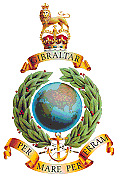Walmer and Deal have a long and proud association with the Royal Marines - the elite commando force which is equally at home at sea as on land. However, the area's military connections stretch back even further than 1861 when the Marines took up residence in existing local barracks - all located in Walmer.
The North and the South Barracks had been built in around 1794. A Royal Naval Hospital was added in 1800-12 and from 1930 the buildings housed the Royal Naval School of Music which was renamed the Royal Marines School of Music in 1950.
On February 14, 1945, the Royal Marines were granted the Freedom of the town of Deal, giving them the right to march through the town with fixed bayonets, drums beating and colours flying. The Marines were also honoured by Royal visits on a number of occasions. Notably, during one of these - on 7 March 1918 - King George V inspected Royal Marines Recruit Squads and took the salute of the 4th Battalion at the March Past. Six weeks later the 4th Battalion were to storm ashore in the raid on Zeebrugge, where they won great fame and two Victoria Crosses. To mark his visit, the King directed that the senior Recruit Squad in Royal Marines training would in future be known as the King's Squad and that a new award, the King's Badge (comprising his Royal Cypher surrounded by a Laurel wreath), be introduced for the best all round recruit in the King's Squad. The privileges of the King's Squad and Badge award have continued to the present day.
In 1989, an IRA bomb killed 11 musicians from The Royal Marines School of Music in East Barracks. Their names are recorded on the Memorial Bandstand, erected in 1993 on Walmer Green. (For more on the bandstand, CLICK HERE.)
Despite huge local concern, a government decision to close the Deal military base resulted in the Marines relocating to Portsmouth in 1996. On Thursday, 21 March 1996 an estimated 6,000 people braved pouring rain to witness the Massed Bands beating the retreat in the South Barracks. Yet more lined the streets or watched from windows for the bandsmen's farewell march along Walmer's Strand and into the East Barracks.
The links with the Marines remain strong, though, and local residents are heartened by an annual visit by the bandsmen to provide a concert at the Memorial Bandstand.
 |
 |
| The Royal Marines annual visit to Walmer, 2005 |
 |
| The Royal Marines parade on Walmer Green, 2005 |
 |
| The Memorial Bandstand on Walmer Green |
 |
| Admiralty Mews - the former East Barracks, Naval Hospital and Royal School of Music |
 |
| The King's Badge - honouring top recruits |
 |
| The 11 musicians killed in the 1989 bombing |
|
For more photos of the Royal Marines
at Walmer, go to our Photo Album |
The four barracks - past and present
Following the departure of the military, the four substantial barracks areas were sold for re-development as private housing. East Barracks is now known as Admiralty Mews; the South Barracks became Cavalry Barracks; the North Barracks is now The Churchills; and the Infirmary Barracks is now Marine Mews.
Admiralty Mews was the site of the naval hospital, rebuilt in 1812 after being struck by lightning. To the south of the hospital, four imposing houses known as Royal Buildings were erected for senior staff. In the latter half of the 19th century, buildings were added to the west to meet the needs of the Royal Marines Depot. Conversion of these buildings into residential units began in 1997 but the external features of the hospital buildings and later additions remain largely unchanged.
Cavalry Barracks was the home of cavalry and infantry units from 1795. As well as military accommodation, the site eventually included drill and playing fields and the barracks church of St Michael's and All Angels, consecrated in 1907. The Jubilee Gates on the Dover Road entrance are believed to commemorate Queen Victoria's Jubilee in 1887. Conversion of the existing buildings to housing had to take careful account of their importance as examples of the country's first military barracks with many protected by Grade II listing. The 30-acre site also has new properties and a resited primary school but the original open spaces have been retained.
The North Barracks also dates from 1795. It was designed as a military hospital but was always used as a barracks. The western half of the site has been demolished and replaced by The Churchills, a high-density development of family homes. Part of the remainder of the site is also designated for redevelopment but some features of the earlier barracks remain. These include: officers' houses and a guardhouse erected on the northern boundary between 1810 and 1830; a military cemetery along the western wall; a Memorial Garden marking the site of the IRA bombing in 1989; and the surviving gable wall of the original barracks chapel built in 1858 but largely destroyed by fire in 2003.
Marine Mews - a high-density development with terraces, houses, flats and sheltered accommodation on the west of Gladstone Road - has been created on the site of the former Infirmary Barracks. The infirmary opened in 1900 on a former drill field and was in use until 1988, when the site was sold and redeveloped. Only the perimeter walls have survived.